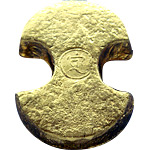Official Japanese coin history begins in the year 708, with the introduction of the wadoukaichin, a simple round coin with a square hole based on Chinese coins of the era. These first coins were used until 760, when the first of several currency reformations occurred.
Japan continued to use various forms of official currency until 958, when coins were abandoned altogether and rice was reinstated as the medium of trade. This lasted until the 1100s, when Japan realized that increased trade necessitated currency once again.
And so Japan began using imported (through legal trade, or via smuggling) Chinese coins. This system lasted 500 years, though in the 1300s Japanese people began producing copies of Chinese coins to fulfill their needs. These copies, while numerous, were considered very low value.
China rare coins for collectors and other buyers
Groups in Japan began trying to produce a new Japanese currency during the 1500s, resulting in the thick, quirkily-shaped gold bundoukin. Eventually, in 1601, the Tokugawa shogunate made advancements in true Japanese coinage, including gold, silver, and bronze coins in a variety of shapes and sizes.
Between 1854 and 1868, there were competing and non-standardized coins produced in a variety of places. This chaotic currency situation came to an end in 1871, with the introduction of the yen.
Today, the yen is the only unit used in Japan; older subdivisions sen and rin have been discontinued.











